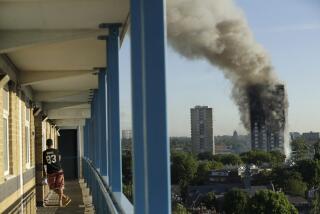British Nuclear Accident Cover-up Stirs Controversy
- Share via
LONDON — A heated controversy erupted Thursday over the release of secret documents that showed U.S. officials were informed of a major British nuclear accident 30 years ago while the public was deliberately kept in the dark.
The documents revealed for the first time the full findings of inquiries into the 1957 disaster at the Windscale plant in northwest England, which manufactured plutonium for military purposes.
No one was killed in the accident, which occurred when a fire broke out in the uranium core of the reactor and raged for 16 hours, releasing contaminated particles into the atmosphere.
But the true extent of the accident--the world’s worst before the 1986 Chernobyl disaster in the Soviet Union and believed responsible for dozens of cases of terminal cancer--was covered up until now.
A spokesman for Britain’s Atomic Energy Authority (AEA) said the cover-up was motivated less by fears of public opinion than by fears that the full story could jeopardize Britain’s nuclear links with the United States.
‘A High Political Level’
“The guidance came from a high political level and was primarily concerned with the impact that full disclosure would have had on the Americans’ perception,” Mark Baker, AEA secretary, said.
The new disclosures brought strong criticism from the opposition Labor Party. “It is only too typical of Whitehall (the government) that they trusted the Americans with information they were not willing to share with the people they are supposed to serve,” said Robin Cook, the Labor Party’s designate for Health and Social Security Secretary.
According to the official documents--published under regulations which govern the release of classified papers after set periods of time--then-Prime Minister Harold Macmillan ordered a report on Windscale to be rewritten after AEA members said they were concerned about its findings.
Not in Public Interest
Macmillan told a Cabinet meeting a month after the Oct. 10 accident that after carefully studying the report, he had come to the conclusion that its publication would not be in the public interest.
The released documents show that not only was the original report suppressed, but major efforts were made to ensure all circulating copies were returned.
However, information in the original inquiry was given to members of a U.S. atomic energy team.
The reactors, contaminated with radioactive debris and tons of melted and partly burned fuel, remain highly dangerous but are sealed to contain radiation.
More to Read
Sign up for Essential California
The most important California stories and recommendations in your inbox every morning.
You may occasionally receive promotional content from the Los Angeles Times.













